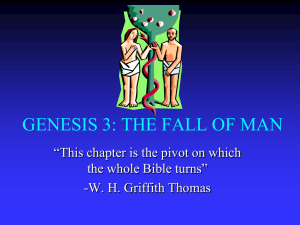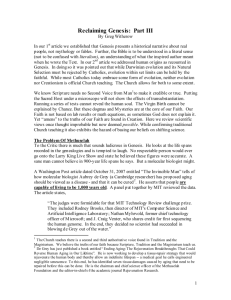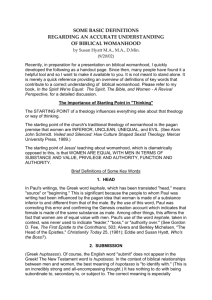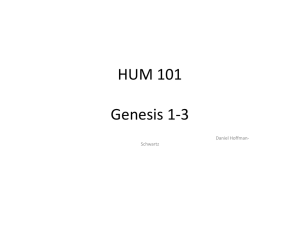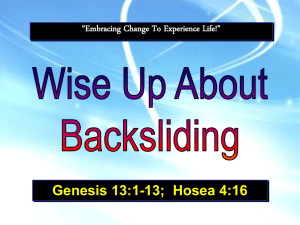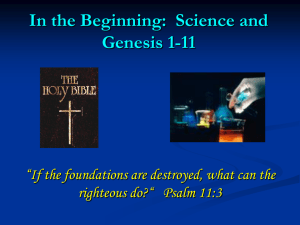Genesis
advertisement
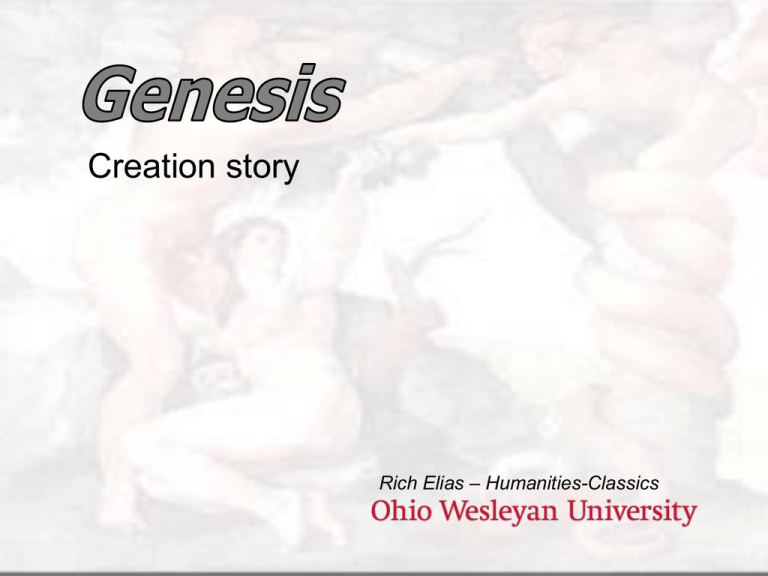
Creation story Rich Elias – Humanities-Classics First Considerations • Genesis is a sacred text. Define! • First book of Jewish Torah and of the Christian Bible. • Its importance and interpretation(s) are different in Judaism and in Christianity. • By studying it as a myth text, we increase our understanding without necessarily affecting our beliefs. Implications What assumptions may prevent us from examining the text in its historical context? – Is the serpent Satan? Who is Satan? – Was the fruit an apple? Why do we think it is? – Did mankind “fall”? In what sense? – What is “original sin”? Where and why did this idea develop? Looking for Satan and Eve . . . • Search a concordance for “Satan” click • Search a concordance for “Eve” click • How do references in the Old Testament differ from references in the New Testament? • What do these differences suggest about the possible meanings of the Genesis stories? Two Creation Stories • Genesis as we have it includes two different creation stories: The JahwistElohist and the Jahwist. look this up! • These were written at different periods in the centuries before the common era. • The first in sequence (Gen. 1 to 2:4) is NEWER than the second 2:4 to end of Gen. 3) • WHAT ARE THE KEY DIFFERENCES BETWEEN THE TWO ACCOUNTS? Differences? Genesis and Middle Eastern Myth • Strong parallels to Enuma Elish which you will read next. • These parallels can be found in both the J-E and J accounts. • Enuma is more concerned with theomachy and cosmogony. Genesis is more concerned with humankind’s relationship with God and with the created world. The Ancient Middle East Comparison of sequence of creation in Enuma Elish and the 1st account in Genesis. -- From E.A. Speiser, Genesis. Anchor Bible. Genesis and Enuma Elish? • Conrad Hyers, from Princeton Theological Seminary, argues that the composition of the Genesis 1 creation account is not "a matter of borrowing, as one might borrow an egg here and a cup of sugar there, or even a new recipe. The aim is not to appropriate a superior form, or to make an eclectic compromise, or even to improve upon pagan cosmologies. It is rather to repudiate the divinization of nature and the attendant myths of divine origins, divine conflict, and divine ascent. Even the great Marduk, who was said to be born of the gods, victorious over chaotic forces, and elevated to supremacy among the gods, was no god at all." Conrad Hyers, The Meaning of Creation: Genesis and Modern Science, John Knox, 1984. Folklore Motifs and Themes • Creation from dust of the earth (J-E) vs. “in his image” (P) • Creation in a garden. Compare Enuma Elish. • Aetiologies: of death, pain in childbirth, etc. • Myth of decline? Compare Hesiod’s five ages. • A test? Folklore theme? Something to do vs. something not to be done? • Serpent as trickster? Is There Folklore in the Bible? • Analysis: Sir J.G. Frazer’s interpretation of the story of mankind’s fall in Genesis. • One premise: the two trees mentioned in the story. • A second premise: similarities between motifs in Genesis and two common folktale themes: • The perverted message • The cast skin Two Trees? • Frazer’s hypothesis: Indeed, far from being prohibited to eat of the tree of life, man was implicitly permitted, if not encouraged, to partake of it by his Creator, who had told him expressly, that he might eat freely of every tree in the garden, with the single exception of the tree of the knowledge of good and evil. Thus by planting the tree of life in the garden and not prohibiting its use, God apparently intended to give man the option, or at least the chance, of immortality, but man missed his chance by electing to eat of the other tree, which God had warned him not to touch under pain of immediate death. This suggests that the forbidden tree was really a tree of death, not of knowledge, and that the mere taste of its deadly fruit, quite apart from any question of obedience or disobedience to a divine command, sufficed to entail death on the eater. The inference is entirely in keeping with God s warning to man, " Thou shalt not eat of it : for in the day that thou eatest thereof thou shalt surely die." Accordingly we may suppose that in the original story there were two trees, a tree of life and a tree of death ; that it was open to man to eat of the one and live for ever, or to eat of the other and die ; that God, out of good will to his creature, advised man to eat of the tree of life and warned him not to eat of the tree of death ; and that man, misled by the serpent, ate of the wrong tree and so forfeited the immortality which his benevolent Creator had designed for him. -- from Folklore in the Old Testament, Vol 1 (1918) Frazer’s Analysis • Perverted message: humans had the chance to eat the fruit of immortality but the messenger (the serpent) deliberately distorted the message. • The cast skin: animals can rejuvenate by shedding their old skin, but humans missed this chance. Excerpt from Frazer • Both of these motifs focus on how mankind lost the chance at immortality. • Frazer’s comparative approach: pluses and many minuses. J.G. Frazer, Folklore in the Old Testament. This is his retelling of the tree story. Adam’s Wives • Two creation stories = two wives? • Conflicting ideas on procreation? • Folk legends about Lilith click Wife #2 Eve • Is Eve a demoted goddess? Is Eve a Demoted Goddess? • Hebrew monotheism? True or not? • Rigid patriarchy. Example: Eve is born from Adam! • Genesis’ emphasis on “be fruitful” versus the punishment of pain in childbirth and “your desire shall be for your husband.” • Ancient Judaism often defined its beliefs in contradistinction to beliefs of neighbors in the ancient near and middle east. • Everybody else has a Great Goddess. Why not the Jews? • Asherah and El? Why a Serpent? Minoan Snake Goddess (Crete) Neolithic Snake Goddess Astarte (= Ishtar = Aphrodite) Playboy cover Snakewitch stone (Sweden) Michelangelo, Fall of man. Sistine Chapel ceiling in the Vatican. Notice how the serpent is depicted. Robert Alter: The name “Eve” is said to be similar to the Aramaic word for serpent. Eve: Scapegoat or Hero? • The “Fall of Man”? How does Eve figure in Christian interpretations? Why is Mary called “the second Eve”? – Misogyny in the Old Testament • Eve as culture hero? Knowing good and evil enables freedom of will. Expulsion from Eden is a kind of birth. Additional References to Examine • Quick overview of Dundes’ ideas • Wikipedia on Ancient Near Eastern context • Ancient Near Eastern Texts, ed. Pritchard • Myths from Mesopotamia, ed. and trans. S. Dalley • Video interview w/Richard Elliot Friedman on Who Wrote the Bible?
